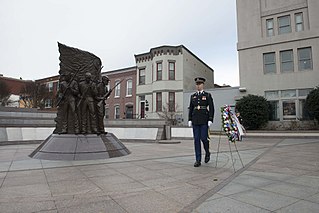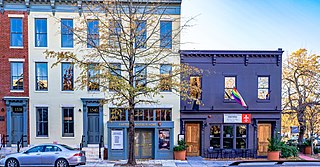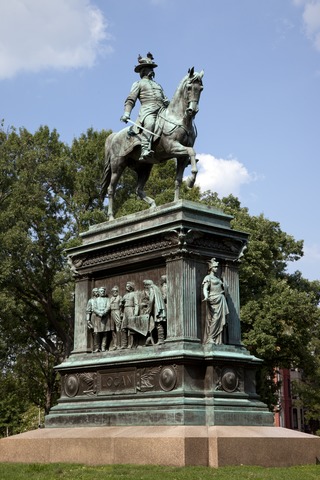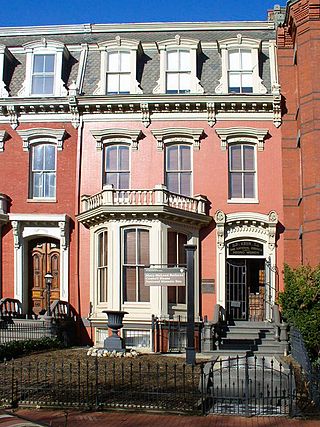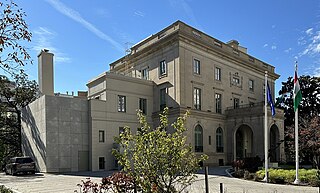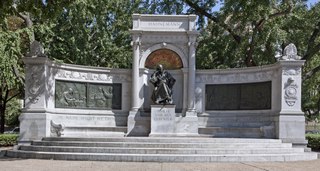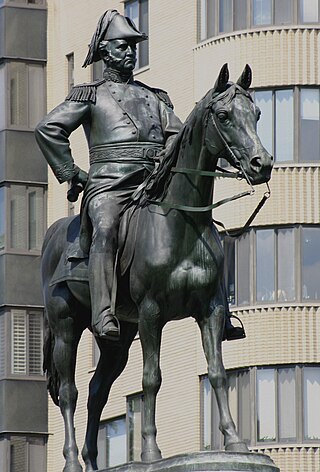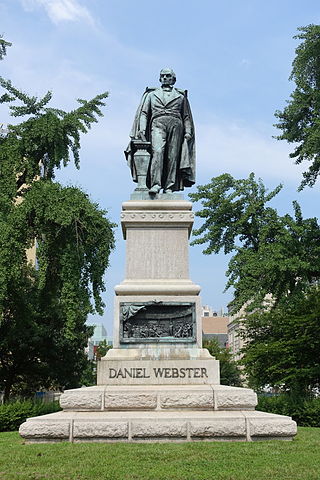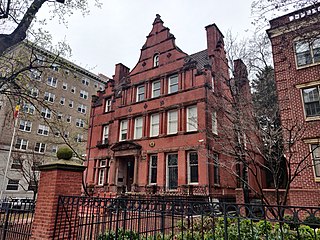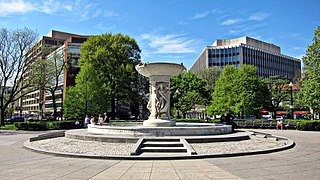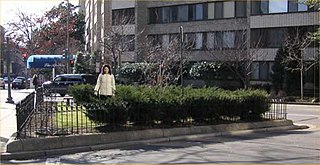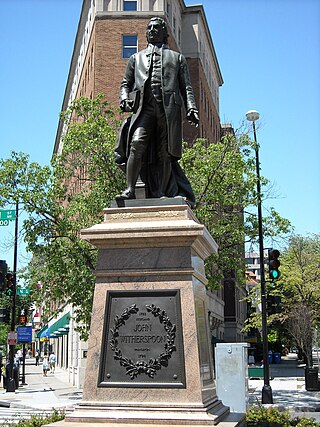Self-guided Sightseeing Tour #9 in Washington, United States
Legend
Tour Facts
5 km
46 m
Experience Washington in United States in a whole new way with our free self-guided sightseeing tour. This site not only offers you practical information and insider tips, but also a rich variety of activities and sights you shouldn't miss. Whether you love art and culture, want to explore historical sites or simply want to experience the vibrant atmosphere of a lively city - you'll find everything you need for your personal adventure here.
Individual Sights in WashingtonSight 1: African American Civil War Memorial
The African American Civil War Memorial is a memorial located in Washington, D.C., the capital of the United States, at the corner of Vermont Avenue, 10th Street, and U Street. It commemorates the 209,145 African-American soldiers and sailors who fought for the Union in the American Civil War. The site is managed by the federal government's National Park Service.
Sight 2: Carter G. Woodson Home National Historic Site
Carter G. Woodson Home National Historic Site at 1538 9th Street NW, in the Shaw neighborhood of Washington, D.C., preserves the home of Carter G. Woodson (1875–1950). Woodson, the founder of Black History Month, was an African-American historian, author, and journalist.
Wikipedia: Carter G. Woodson Home National Historic Site (EN)
Sight 3: Major General John A. Logan Monument
Major General John A. Logan, also known as the General John A. Logan Monument and Logan Circle Monument, is an equestrian statue in Washington, D.C., that honors politician and Civil War general John A. Logan. The monument is sited in the center of Logan Circle, a traffic circle and public park in the Logan Circle neighborhood. The statue was sculpted by artist Franklin Simmons, whose other prominent works include the Peace Monument and statues in the National Statuary Hall Collection. The architect of the statue base was Richard Morris Hunt, designer of prominent buildings including the Metropolitan Museum of Art in New York City and The Breakers in Newport, Rhode Island. Prominent attendees at the dedication ceremony in 1901 included President William McKinley, members of his cabinet, Senator Chauncey Depew, Senator Shelby Moore Cullom, and General Grenville M. Dodge.
Sight 4: Mary McLeod Bethune Council House
The Mary McLeod Bethune Council House National Historic Site preserves the house of Mary McLeod Bethune, located in Northwest Washington, D.C., at 1318 Vermont Avenue NW. National Park Service rangers offer tours of the home, and a video about Bethune's life is shown. It is part of the Logan Circle Historic District.
Wikipedia: Mary McLeod Bethune Council House National Historic Site (EN)
Sight 5: Brodhead-Bell-Morton Mansion
The Brodhead-Bell-Morton Mansion, also known as the Levi P. Morton House is a historic Beaux-Arts home, located at 1500 Rhode Island Avenue, Northwest, Washington, D.C., in the Logan Circle neighborhood.
Sight 6: Hahnemann Monument
The Samuel Hahnemann Monument, also known as Dr. Samuel Hahnemann, is a public artwork dedicated to Samuel Hahnemann, the founder of homeopathy. It is located on the east side of Scott Circle, a traffic circle in the northwest quadrant of Washington, D.C. The Classical Revival monument consists of an exedra designed by architect Julius Harder and a statue sculpted by Charles Henry Niehaus, whose works include the John Paul Jones Memorial in Washington, D.C., and several statues in the National Statuary Hall Collection. The monument is significant because Hahnemann is the first foreigner not associated with the American Revolution to be honored with a sculpture in Washington, D.C.
Sight 7: Lieutenant General Winfield Brevet Scott Statue
Brevet Lt. General Winfield Scott is an equestrian statue in Washington, D.C., that honors career military officer Winfield Scott. The monument stands in the center of Scott Circle, a traffic circle and small park at the convergence of 16th Street, Massachusetts Avenue and Rhode Island Avenue NW. The statue was sculpted by Henry Kirke Brown, whose best-known works include statues of George Washington in New York and Nathanael Greene in Washington, D.C. It was the first of many sculptures honoring Civil War generals that were installed in Washington, D.C.'s traffic circles and squares and was the second statue in the city to honor Scott.
Sight 8: Daniel Webster Memorial
The Daniel Webster Memorial is a monument in Washington, D.C., honoring U.S. statesman and lawyer Daniel Webster. It is located near Webster's former house, beside Scott Circle, at the intersection of Massachusetts Avenue, N Street, and Rhode Island Avenue NW. The person who commissioned the memorial was Stilson Hutchins, founder of The Washington Post, who greatly admired Webster. Congress approved the memorial in 1898 and the dedication ceremony took place in January 1900. Amongst the attendees at the ceremony were President William McKinley and his cabinet, members of Congress, and Supreme Court justices.
Sight 9: Stead Park Recreation Center
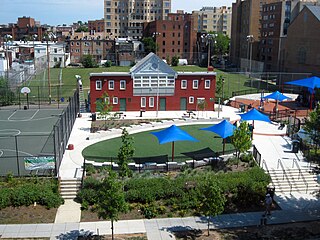
Stead Park is a 1.5-acre municipal park located in the Dupont Circle neighborhood of Northwest Washington, D.C. Among its facilities are Stead Recreation Center, located at 1625 P Street NW; a lighted basketball court; an athletic field with a 60-foot (18 m) baseball diamond; and a playground.
Sight 10: Toutorsky Mansion
The Toutorsky Mansion, also called the Brown-Toutorsky House, is a five-story, 18-room house located at 1720 16th Street, NW in the Dupont Circle neighborhood of Washington, D.C. Since 2012, it has housed the Embassy of the Republic of the Congo.
Sight 11: National Museum Of American Jewish Military History
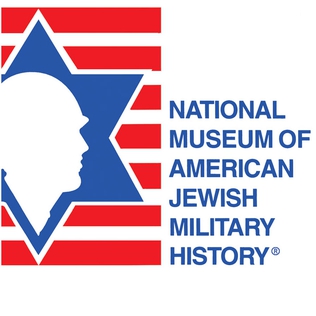
The National Museum of American Jewish Military History (NMAJMH) was founded September 2, 1958, in Washington, D.C., to document and preserve "the contributions of Jewish Americans to the peace and freedom of the United States...[and to educate] the public concerning the courage, heroism and sacrifices made by Jewish Americans who served in the armed forces." It operates under the auspices of the Jewish War Veterans of the United States of America (JWV), National Memorial, Inc. (NMI), and is located at 1811 R Street NW, Washington, D.C., in the Dupont Circle area, in the same building that houses the JWV National Headquarters.
Wikipedia: National Museum of American Jewish Military History (EN), Website
Sight 12: Dupont Circle
Dupont Circle is a historic roundabout park and neighborhood of Washington, D.C., located in Northwest D.C. The Dupont Circle neighborhood is bounded approximately by 16th Street NW to the east, 22nd Street NW to the west, M Street NW to the south, and Florida Avenue NW to the north. Much of the neighborhood is listed on the National Register of Historic Places. However, the local government Advisory Neighborhood Commission and the Dupont Circle Historic District have slightly different boundaries.
Sight 13: Sonny Bono Park
Sonny Bono Memorial Park is a public park in Washington, D.C., at the intersection of 20th Street NW, New Hampshire Avenue NW, and O Street NW, near Dupont Circle. It is named for entertainer and politician, Sonny Bono, who died in a skiing accident in 1998. The park was established later that year by Bono family friend, Geary Simon, a local real estate developer. He approached the District of Columbia Department of Parks and Recreation's Adopt-a-Park program and paid over $25,000 of his own money to revitalize an unused 800-square-foot (74 m2) triangle of grass on a traffic island. His improvements to the park included plumbing, landscaping, and installing new furniture.
Sight 14: John Witherspoon Statue
Doctor John Witherspoon is a bronze sculpture and granite pedestal which depicts John Witherspoon, a Presbyterian minister, member of Congress, and signer of the Declaration of Independence. Born in Scotland, Witherspoon immigrated to the U.S. in the 1760s and later became president of the College of New Jersey. He strongly supported the Thirteen Colonies in their fight to obtain freedom from the United Kingdom of Great Britain and Ireland.
Share
How likely are you to recommend us?
Disclaimer Please be aware of your surroundings and do not enter private property. We are not liable for any damages that occur during the tours.
GPX-Download For navigation apps and GPS devices you can download the tour as a GPX file.
